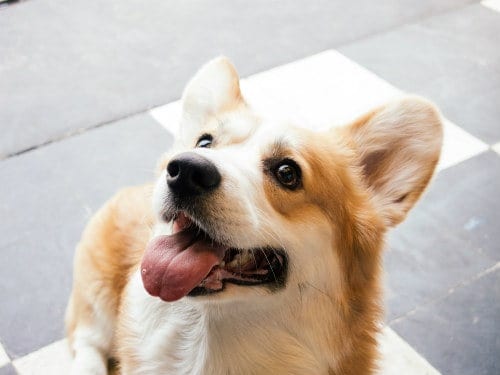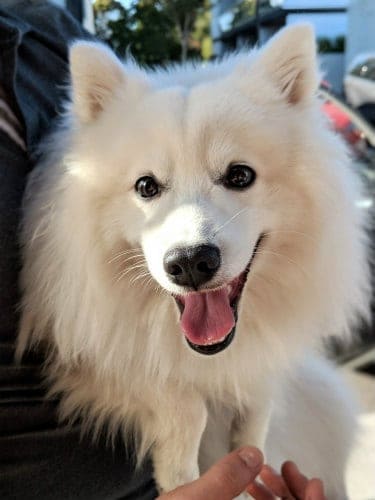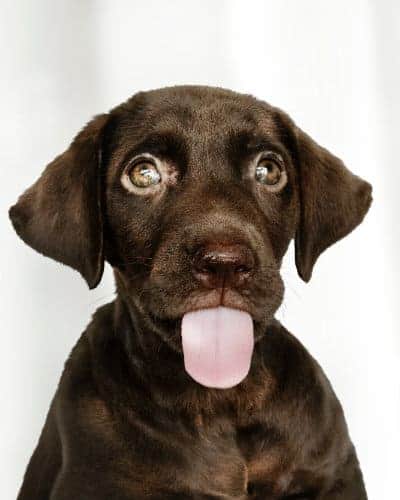It’s normal for a dog to pant while exercising or when the weather’s hot. In fact, it’s such a typical behavior that most dog owners never think twice about it. When you see your dog with its mouth open and its tongue hanging out, it’s easy to assume that everything is just as it should be, and usually, that’s the case.
Dogs pant reflexively in many different scenarios. Though it’s not typically cause for concern, it’s still important to know what panting is and how to tell when this everyday dog behavior is a symptom of a more serious problem.
Let’s learn more about dog physiology and anatomy and find out all the reasons why dogs pant.
Breathe Deep and Keep Cool: Dog Respiration and Temperature Regulation
Temperature Tribulations

As warm-blooded animals, dogs and humans have one significant commonality: we both regulate our body temperatures. By doing so, we’re able to survive in a wide range of climates, from sun-scorched deserts to bone-chilling tundras.
That’s why the dog species boasts such diverse members as the Chihuahuas of Mexico and the huskies of Siberia – no matter what the weather is outside, they’re able to keep all their systems running at optimal temperatures.
The ideal body temperature varies from dog to dog and depends on age, health, breed, and other genetics. Generally, a dog’s core temperature is around 101.5 degrees Fahrenheit, but it can range from 100 to 103 degrees.
Puppies tend to have lower body temperatures than adult dogs, dipping as low as 94 degrees for newborns, which is why it’s so important for puppies to stick close to their mother and absorb her body heat.
It’s Getting Hot in Here
When it’s cold out, dogs make their own body heat in a number of ways, the most basic of which is blood circulation – the movement of blood through the body produces heat through friction. Metabolism plays an important role in the digestive process, breaking down glucose and producing cell-sustaining compounds, but it has the added bonus of generating heat as a byproduct. This heat is then stored in the dog’s insulating layers of fat and fur; when that’s not enough to keep warm, the dog shivers, producing even more heat through its muscle vibrations.
Chilling Out

Keeping cool when it’s hot out is a much tougher ordeal. The body still has to metabolize food and circulate blood regardless of the temperature outside, so it continues to produce heat even when what it really needs is to cool itself down. We tackle this problem by sweating, releasing the hottest moisture molecules from our bodies so that they can evaporate, leaving only the cooler water behind.
Sweating works well for us because we have such broad areas of exposed skin from which sweat can evaporate, but dogs don’t have this luxury. They don’t have sweat glands except in their paw pads and the insides of their ears, and even if they had more they probably wouldn’t find sweating very effective due to their smaller surface areas and (often) thick coats of fur. So they have to turn to another cooling tactic when things get too hot: panting.
Getting Their Pants On
Panting depends on evaporation just like sweating does, but it’s a bit more active and strenuous. Rather than passively releasing sweat from their pores, dogs allow their saliva to evaporate by opening their mouths and letting their tongues hang out. As air passes through the mouth and over the tongue, it picks up the hottest water molecules and carries them away; this takes place in the moist lungs as well.
But it’s harder to get large amounts of air to pass through your mouth than it is to just stand there and let the wind hit your exposed skin, so it’s not enough to simply let your jaw hang low. Dogs increase the rate of evaporation by breathing faster, forcing more air to circulate and draw heat from the lungs and mouth. This results in their trademark panting: heavy breathing as a form of evaporative cooling.
Limber Lungs

A dog’s normal rate of breathing is between 10 and 40 breaths per minute, tending towards the lower end for large dogs and the upper end for smaller dogs. On average, dogs take about 25 breaths per minute when they’re at rest. Knowing your dog’s normal breathing rate is important for monitoring its health, so you can measure it by counting the number of breaths it takes over 15 seconds and multiplying the result by four to get the number of breaths per minute.
When a dog overheats, its normal rate of breathing just won’t cut it. To maximize the power of evaporative cooling, the dog increases its breathing rate tenfold or more, taking a whopping 300 to 400 breaths per minute. In order to occur so rapidly, the breaths become much shallower than normal and are often noisier as well; all the motion in the airways creates the huffing and puffing sound we associate with panting.
Optimal Oxygenation
The body requires fresh oxygen with which to supply the circulatory system. When blood oxygen levels drop too low, such as when blood pressure rises due to increased heart rate during exercise, the respiratory system responds by increasing the rate of breathing in order to take in more oxygen. This is why dogs pant during and after physical exertion regardless of whether it’s hot or not – sometimes panting isn’t just about cooling down, it’s about getting more oxygen into the bloodstream.
Regular Respiration: When Panting Is Normal
Now that we know what panting does and why it’s so necessary for dogs, let’s go over what normal panting looks like and when you can expect to see it.
After a Good Workout
An invigorating run around the neighborhood or a challenging gym session will leave a human sweating and breathing hard, and dogs are no different. Panting during and after exercise delivers extra oxygen to the blood, allowing it to continue circulating properly and keep powering all of the dog’s vital organs. Plus all that physical exertion generates a lot of body heat thanks to the friction of moving muscles and joints, so panting helps that excess heat dissipate and keeps everything running at its ideal temperature.
Make sure to give your dog plenty of fresh water when exercising to maintain good hydration and minimize the need for cooling via panting. If it’s really hot outside, you can drape your dog in a cool, damp towel after a run or a hike to speed up the cooldown. With proper hydration and a shady place to rest, it shouldn’t take more than a few minutes for the dog’s temperature and heart rate to return to normal after exercising, so panting should subside quickly post-workout.
During a Heat Wave
When temperatures rise close to or above a dog’s normal body temperature of around 101.5 degrees Fahrenheit, it becomes much harder for the body to keep itself cool. This applies even if the dog is just sitting there without exerting itself. Just as we begin to sweat when the air approaches our body temperature, so too do dogs start panting when the room heats up.
Even though panting helps to keep a dog cool, it can only do so much for so long. If it’s hot and your dog is panting while at rest, it’s a good idea to provide some external cooling to minimize stress and moisture loss. A shady area, a bowl of fresh water, and some breeze from the wind or a fan will help cool your pup down and reduce the need for panting.
In Stressful Situations

When we’re nervous before giving a speech or startled by an unexpected noise, our breathing quickens and we start to sweat. This physiological response to stress and anxiety is also present in dogs, who pant when they feel scared, threatened or apprehensive. These emotions cause spikes in body temperature and blood pressure, necessitating some evaporative cooling and extra oxygen.
It’s normal for a dog to start panting when it’s feeling fearful; common frights include thunderstorms, fireworks, the vet’s office, and strangers. In addition to panting, dogs can display other anxiety symptoms such as shaking, widening the eyes, pacing, whimpering, and holding the tail between the legs. Once the stressful situation is over, the body returns to normal functioning within a few minutes and the panting subsides.
When Breathing Goes Bad: Abnormal Panting
Sometimes panting is a sign that something’s wrong. Abnormal panting tends to be heavier, louder and longer-lasting than regular panting, and may involve a full body effort to perform. When none of the above situations apply to your dog but it continues to pant, it could indicate one of the following problems.
Heatstroke
Sometimes it’s so hot that not even the most vigorous panting can cool the body down enough. When a dog’s body temperature is too high for too long, various systems begin to malfunction and shut down. This is called heatstroke, a medical emergency that can also cause confusion, diarrhea and fainting.
Dogs with long or thick coats, brachycephalic (short-nosed) dogs such as pugs and bulldogs, senior dogs and dogs that have recently exercised have a particularly high risk of developing heatstroke. When it’s hot outside, all dogs should have their physical activity and sun exposure kept to a minimum to prevent heatstroke. If your dog has recently been exposed to high temperatures and won’t stop panting, monitor it for symptoms of heatstroke and see a vet immediately if the panting persists or the dog’s condition worsens.
Poison or Venom
A bite from a snake or a sting from a bee, wasp or hornet can inject your dog with venom that causes a wide range of symptoms, often including panting. The bite or sting site may swell, itch or hurt, and depending on the source of the venom your dog may experience vomiting, weakness or dizziness. In severe cases, especially if your dog is allergic to the venom, a loss of consciousness may occur.
Poisoning usually results from the dog eating something toxic. This could be food such as chocolate or raisins, pest control products like rat poison or household chemicals like bleach or antifreeze. The symptoms of poisoning depend on what was ingested but often include lethargy, convulsions, vomiting and heavy panting.
If your dog is panting for seemingly no reason, especially if other symptoms are present, check its body for bites or stings and try to identify anything poisonous that the dog could have ingested. Even if you can’t find anything, take your dog to the vet immediately. Many common poisons and venoms can be neutralized or treated if dealt with swiftly, but can cause rapid damage if left untreated.
Illness
Heavy panting is a symptom of many illnesses. These are just a few of the potential conditions that can cause excessive panting. If you suspect your dog has any of these, or if your dog continues to pant inappropriately or excessively, consult a vet.
Cushing’s Disease
Cushing’s disease is characterized by excessive production of cortisol, a stress-related hormone. Symptoms usually begin with heavy panting and may include restlessness, hair loss, thinning and darkening skin, weight gain and frequent urination. Dachshunds, terriers and poodles are especially prone to developing this condition.
Anemia
Anemic dogs have insufficient red blood cells and poorly oxygenated blood, resulting in heavy, rapid breathing. Weakness, poor appetite, pale skin and gums, elevated heart rate and loss of appetite may also occur. Anemia can be life-threatening; to
Anemia sometimes occurs on its own but is often itself a symptom of a larger condition. Malnutrition, heart disease, and various cancers can cause anemia. Your vet will examine your dog and test for these and other conditions in addition to treating the anemia itself.
Laryngeal Paralysis
Laryngeal paralysis is a condition in which the muscles that open and close the airways stop functioning correctly. Rather than opening the larynx to allow air into the lungs, they obstruct the passage or sometimes close it off altogether. This results in raspy, labored panting that occurs regardless of temperature or activity level.
Surgery can be performed to permanently hold the airway open, negating the effects of laryngeal paralysis. Unfortunately, even if respiration is improved, laryngeal paralysis often indicates a more serious neurological condition that may or may not be treatable. Brachycephalic breeds are more prone to developing laryngeal paralysis than long-nosed breeds due to their already-weakened respiratory systems.
